Assessment of the Nutritional Value of Selected Wild Food Plants in Türkiye and Their Promotion for Improved Nutrition
Abstract
1. Introduction
2. Materials and Methods
2.1. Study Areas and Ethnobotanical Studies
- Aegean: İzmir, Aydın, and Muğla;
- Black Sea: Kastamonu and Sinop;
- Central Anatolia: Konya and Karaman;
- Marmara: Balıkesir;
- Mediterranean: Antalya and Mersin.
2.2. Prioritization Process
2.3. Sampling Protocol and Sample Preparation
2.4. Nutrient Analysis
3. Results
3.1. Ethnobotanical Data
3.2. Nutritional Analysis
3.3. Mainstreaming Nutrient-Rich Wild Edibles in Türkiye
3.3.1. Policies
- National Biodiversity Strategy and Action Plan (NBSAP)
- MFAL 2013–2017 Strategic Plan
- 10th National Development Plan 2014–2018
- GDAR Agricultural Research Master Plan 2016–2020
- Healthy Nutrition and Active Life Program 2014–2017
- Nutrition Friendly School Initiative
- Nutrition and Health Research of Türkiye 2017
- Technical and Vocational Education and Training (TVET) programs
- Türkiye’s National Dietary Guidelines (2016)
- ME Science Teaching Programs/Curriculum
- The Higher Education Strategy (2007–2025)
- Vocational and Education Training (VET) Strategy (2014–2018)
- Türkiye’s Skills Vision 2020
- Action Plan for Strengthening the Link between Education and Employment (İMEİGEP)
- Strategy Document of the Ministry of Agriculture and Forestry (2019–2023)
- National Rural Development Strategy (2021–2023)
- 11th Development Plan (2019–2023)
3.3.2. Markets and Awareness
3.3.3. Education
4. Conclusions
Supplementary Materials
Author Contributions
Funding
Institutional Review Board Statement
Informed Consent Statement
Data Availability Statement
Acknowledgments
Conflicts of Interest
References
- FAO. Biodiversity of Turkey: Contribution of Genetic Resources to Sustainable Agriculture and Food Systems; Muminjanov, H., Karagöz, A., Eds.; Food and Agriculture Organization of the United Nations: Ankara, Turkey, 2018; p. 222. Available online: https://www.fao.org/3/ca1517en/ca1517en.pdf (accessed on 5 July 2022).
- Heywood, V.H. Use and Potential of Wild Plants in Farm Households; FAO Farm System Management Series; FAO: Rome, Italy, 1999; Volume 15. [Google Scholar]
- Doğan, Y.; Baslar, S.; Ay, G.; Mert, H.H. The Use of Wild Edible Plants in Western and Central Anatolia, (Turkey). Econ. Bot. 2004, 58, 684–690. [Google Scholar] [CrossRef]
- Ertuğ, F. Wild Edible Plants of the Bodrum Area (Muğla, Turkey). Turk. J. Bot. 2004, 28, 161–174. [Google Scholar] [CrossRef]
- Kargioğlu, M.; Cenkci, S.; Serteser, A.; Evliyaoğlu, N.; Konuk, M.; Kök, S.M.; Bağcı, Y. An Ethnobotanical Survey of Inner-West Anatolia, Turkey. Hum. Ecol. 2008, 36, 763–777. [Google Scholar] [CrossRef]
- Arı, S.; Temel, M.; Kargıoğlu, M.; Konuk, M. Ethnobotanical survey of plants used in Afyonkarahisar-Turkey. J. Ethnobiol. Ethnomed. 2015, 11, 84. [Google Scholar] [CrossRef]
- Gürdal, B.; Kültür, S. The edible and miscellaneous useful plants in Marmaris (Southwest Turkey). J. Fac. Pharm. Istanb. 2014, 44, 69–78. [Google Scholar]
- Ertuğ, F. An ethnobotanical study in Central Anatolia (Turkey). Econ. Bot. 2000, 54, 155–182. [Google Scholar] [CrossRef]
- Şimşek, I.; Aytekin, F.; Yesilada, E.; Yildirimli, Ş. An ethnobotanical survey of the Beypazarı, Ayaş, and Güdül District Towns of Ankara province (Turkey). Econ. Bot. 2004, 58, 705–720. [Google Scholar]
- Sarper, F.; Akaydin, G.; Şimşek, I.; Yesilada, E. An ethnobotanical field survey in the Haymana district of Ankara province in Turkey. Turk. J. Biol. 2009, 33, 79–88. [Google Scholar] [CrossRef]
- Yeşil, Y.; Akalin, E. The use of wild edible plants in Kurecik (Akcadag/Malatya). J. Fac. Pharm. Istanb. 2010, 41, 90–103. [Google Scholar]
- Korkmaz, M.; Karakuş, S.; Selvi, S.; Çakılcıoğlu, U. Traditional knowledge on wild plants in Üzümlü (Erzincan-Turkey). Indian J. Tradit. Know. 2016, 15, 538–545. [Google Scholar]
- Nadiroğlu, M.; Behçet, L. Traditional food uses of wild plants among the Karlıova (Bingöl-Turkey). Int. J. Nat. Life Sci. 2018, 2, 57–71. [Google Scholar]
- Polat, R.; Guner, B.; Babacan, E.Y.; Çakılcıoğlu, U. Survey of wild food plants for human consumption in Bingöl (Turkey). Indian J. Tradit. Know. 2017, 16, 378–384. [Google Scholar]
- Doğan, A.; Tuzlaci, E. Wild Edible Plants of Pertek (Tunceli-Turkey). Marmara Pharm. J. 2015, 19, 126–135. [Google Scholar] [CrossRef]
- Kaval, I.; Behçet, L.; Çakilcioğlu, U. Survey of wild food plants for human consumption in Geçitli (Hakkari, Turkey). Indian J. Tradit. Know 2015, 14, 183–190. [Google Scholar]
- Mükemre, M.; Behçet, L.; Çakılcıoğlu, U. Survey of wild food plants for human consumption in villages of Çatak (Van-Turkey). Indian J. Tradit. Know 2016, 15, 183–191. [Google Scholar]
- Polat, R.; Çakılcıoğlu, U.; Ulusan, M.D.; Paksoy, M.Y. Survey of wild food plants for human consumption in Elazığ (Turkey). Indian J. Tradit. Know 2015, 1, 69–75. [Google Scholar]
- Koçak, S.; Özhatay, N. Wild edible plants in Karaman (Southern Turkey). Istanb. J. Pharm. 2013, 43, 21–32. [Google Scholar]
- Şenkendareş, İ.; Tuzlacı, E. Wild edible plants in southern part of Nevşehir in Turkey. Marmara Pharm. J. 2016, 20, 34–43. [Google Scholar] [CrossRef]
- Kadıoğlu, Z.; Cukadar, K.; Kalkan, N.N.; Vurgun, H.; Kaya, O. Wild edible plant species used in the Ağrı province, eastern Turkey. An. Jard. Bot. Madr. 2020, 77, e098. [Google Scholar] [CrossRef]
- Kadıoğlu, Z.; Çukadar, K.; Kandemir, A.; Kalkan, N.N.; Vurgun, H.; Dönderalp, V. Kars İlinde Sebze Olarak Tüketilen Yabani Bitki Türlerinin Tespiti ve Kullanım Şekilleri. ANADOLU Ege Tarımsal Araştırma Enstitüsü Derg. 2020, 30, 11–32. [Google Scholar] [CrossRef]
- Çakır, E.A. Traditional knowledge of wild edible plants of Iğdır Province (East Anatolia, Turkey). Acta Soc. Bot. Pol. 2017, 86, 3568. [Google Scholar] [CrossRef]
- Yildirim, E.; Dursun, A.; Turan, M. Determination of the Nutrition Contents of the Wild Plants Used as Vegetables in Upper Çoruh Valley. Turk. J. Bot. 2001, 25, 367–371. [Google Scholar]
- Akgul, A.; Senol, S.G.; Yildirim, H.; Secmen, O.; Dogan, Y. An ethnobotanical study in Midyat (Turkey), a city on the silk road where cultures meet. J. Ethnobiol. Ethnomed. 2018, 14, 12. [Google Scholar] [CrossRef] [PubMed]
- Yeşil, Y.; Çelik, M.; Yılmaz, B. Wild edible plants in Yeşilli (Mardin-Turkey), a multicultural area. J. Ethnobiol. Ethnomed. 2019, 15, 52. [Google Scholar] [CrossRef]
- Yeşil, Y.; İnal, İ. Traditional knowledge of wild edible plants in Hasankeyf (Batman Province, Turkey). Acta Soc. Bot. Pol. 2019, 88, 3633. [Google Scholar] [CrossRef]
- Özbucak, T.B.; Kutbay, H.G.; Akçin, O.E. The contribution of wild edible plants to human nutrition in the Black Sea region of Turkey. Ethnobot. Leafl. 2006, 10, 98–103. [Google Scholar]
- Güneş, S.; Savran, A.; Yavuz, M.; Çakilcioğlu, U. Survey of wild food plants for human consumption in Karaisalı (Adana-Turkey). Indian J. Tradit. Know 2018, 17, 290–298. [Google Scholar]
- Salim, M.; Necattin, T. A survey on wild plants with ethnobotanical use in the Bahçe and Hasanbeyli districts of Osmaniye, Turkey. GSC Biol. Pharm. Sci. 2018, 5, 28–35. [Google Scholar] [CrossRef]
- Kayabaşı, N.P.; Tümen, G.; Polat, R. Wild edible plants and their traditional use in the human nutrition in Manyas (Turkey). Indian J. Tradit. Know 2018, 17, 299–306. [Google Scholar]
- Özdemir, E.; Kültür, Ş. Wild edible plants of Savaştepe District (Balıkesir, Turkey). Marmara Pharm. J. 2017, 21, 578–589. [Google Scholar] [CrossRef]
- Hançer, Ç.K.; Sevgi, E.; Altinbaşak, B.B.; Çakir, E.A.; Akkaya, M. Traditional Knowledge of Wild Edible Plants of Biga (Çanakkale), Turkey. Acta Soc. Bot. Pol. 2020, 89, 3633. [Google Scholar]
- Koçyiğit, M.; Özhatay, N. The wild edible and miscellaneous useful plants in Yalova Province (Northwest Turkey). Istanb. J. Pharm. 2009, 40, 19–29. [Google Scholar]
- Kızılarslan, Ç.; Özhatay, N. An ethnobotanical study of the useful and edible plants in İzmit. Marmara Pharm. J. 2012, 16, 194–200. [Google Scholar] [CrossRef]
- Noroozi, J.; Zare, G.; Sherafati, M.; Mahmoodi, M.; Moser, D.; Asgarpour, Z.; Schneeweiss, G.M. Patterns of Endemism in Turkey, the Meeting Point of Three Global Biodiversity Hotspots, Based on Three Diverse Families of Vascular Plants. Front. Ecol. Evol. 2019, 7, 159. [Google Scholar] [CrossRef]
- Borelli, T.; Hunter, D.; Padulosi, S.; Amaya, N.; Meldrum, G.; de Oliveira Beltrame, D.M.; Samarasinghe, G.; Wasike, V.W.; Güner, B.; Tan, A.; et al. Local Solutions for Sustainable Food Systems: The Contribution of Orphan Crops and Wild Edible Species. Agronomy 2020, 10, 231. [Google Scholar] [CrossRef]
- Gee, E.; Borelli, T.; Beltrame, D.; Oliveira, C.; Coradin, L.; Wasike, V.; Manjella, A.; Samarasinghe, G.; Güner, B.; Tan, A.; et al. The ABC of mainstreaming biodiversity for food and nutrition: Concepts, theory and practice. In Biodiversity, Food and Nutrition: A New Agenda for Sustainable Food Systems, 1st ed.; Hunter, D., Gee, E., Borelli, T., Eds.; Routledge: Abingdon, UK, 2020; pp. 85–186. [Google Scholar]
- Tan, A.; Adanacioğlu, N.; Karabak, S.; Aykas, L.; Tas, N.; Taylan, T. Biodiversity for Food and Nutrition: Edible Wild Plant Species of the Aegean Region of Turkey. ANADOLU J. AARI 2017, 27, 1–8. [Google Scholar]
- Güner, A.; Aslan, S.; Ekim, T.; Vural, M.; Babaç, M.T. (Eds.) Turkey Bitkileri Listesi (Damarlı Bitkiler). List of Turkish Plants (Vascular Plants); Nezahat Gökyiğit Botanik Bahçesi ve Flora Araştırmaları Derneği Yayını: İstanbul, Turkey, 2012. [Google Scholar]
- Koyu, E.B. TÜRKİYE’NİN ETNOBOTANİK VERİTABANI. Ethnobotanical Database of Turkey. Ph.D. Thesis, Ege University, İzmir, Turkey, 4 February 2020. [Google Scholar] [CrossRef]
- FAO. The State of the World’s Biodiversity for Food and Agriculture; Bélanger, J., Pilling, D., Eds.; FAO Commission on Genetic Resources for Food and Agriculture Assessments: Rome, Italy, 2019; p. 572. Available online: http://www.fao.org/3/CA3129EN/CA3129EN.pdf (accessed on 5 July 2022).
- Şekercioğlu, Ç.H.; Anderson, S.; Akçay, E.; Bilgin, R.; Emre Can, Ö.; Semiz, G.; Tavşanoğlu, Ç.; Baki Yokeş, M.; Soyumerth, A.; İpekdal, K.; et al. Turkey’s globally important biodiversity in crisis. Biol. Conserv. 2011, 144, 2752–2769. [Google Scholar] [CrossRef]
- FAO. The State of the Turkey’s Biodiversity for Food and Agriculture; Ministry of Food, Agriculture and Livestock, Ed.; Country Report; FAO Commission on Genetic Resources for Food and Agriculture: Rome, Italy, 2019; p. 16. Available online: https://www.fao.org/3/CA3505EN/ca3505en.pdf (accessed on 5 July 2022).
- Schunko, C.; Li, X.; Klappoth, B.; Lesi, F.; Porcher, V.; Porcuna-Ferrer, A.; Reyes-García, V. Local communities’ perceptions of wild edible plant and mushroom change: A systematic review. Glob. Food Secur. 2022, 32, 100601. [Google Scholar] [CrossRef]
- Rayne, S.; Mazza, G. Biological activities of extracts from Sumac (Rhus spp.): A review. Plant Foods Hum. Nutr. 2007, 62, 165–175. [Google Scholar] [CrossRef]
- Keser, S.; Keser, F.; Kaygili, Ö.; Tekin, S.; Türkoğlu, İ.; Demir, E.; Türkoğlu, S.; Karatepe, M.; Sandal, S.; Kirbağ, S. Phytochemical compounds and biological activities of Celtis tournefortii fruits. Anal. Chem. Lett. 2017, 7, 344–355. [Google Scholar] [CrossRef]
- Pieroni, A.; Ahmed, H.M.; Zahir, H. The spring has arrived: Traditional wild vegetables gathered by Yarsanis (Ahl-e-Haqq) and Sunni Muslims in Western Hawraman, SE Kurdistan (Iraq). Acta Soc. Bot. Pol. 2017, 86, 3519. [Google Scholar] [CrossRef]
- Karaaslan, Ö.; Çöteli, E.; Karataş, F. Investigation of amounts of A, E, C vitamins with malondialdehyde and glutathione in plant Gundelia tournefortii. Erzincan Üniv. Fen Bilim Enst. Derg. 2014, 7-2, 159–168. [Google Scholar] [CrossRef][Green Version]
- Turkey Ministry of Health. Turkey Nutrition and Health Survey; Tiraj Basim Ve Yayin Sanayi Ticaret Ltd. Sti.: Ankara, Turkey, 2019. Available online: https://hsgm.saglik.gov.tr/depo/birimler/saglikli-beslenme-hareketli-hayat-db/TBSA_RAPOR_KITAP_2017_ENG_.pdf (accessed on 5 July 2022).
- Hacettepe University Institute of Population Studies. 2018 Turkey Demographic and Health Survey; T.R. Presidency of Turkey Directorate of Strategy and Budget and TÜBİTAK; Elma Teknik Basım Matbaacılık Ltd. Şti.: Ankara, Turkey, 2019; p. 282. [Google Scholar]
- Turkey Ministry of Agriculture and Forestry. Towards Sustainable Food Systems, National Pathway of Turkey; TARIMORMAN: Ankara, Turkey, 2021. Available online: https://www.tarimorman.gov.tr/ABDGM/Belgeler/Uluslararas%C4%B1%20Kurulu%C5%9Flar/NATIONAL%20PATHWAY%20OF%20TURKEY_BOOKLET_28%20kas%C4%B1m%2002.pdf (accessed on 2 September 2022).
- Tan, A.; Taskin, T. Ege Bölgesinde Sebze Olarak Kullanilan Yabani Bitki Turleri ve Kullanim Amacları. (Edible Wild Species used as Vegetables in the Aegean Region). In İzmir: Tarım ve Köyişleri Bakanlığı Ege Tarımsal Araştırma Enstitüsü Müdürlüğü—Aliağa Kaymakamlığı Köylere Hizmet Götürme Birliği Başkanlığı; Series 136. 174 s; Aegean Agricultural Research Institute: İzmir, Turkey, 2009; ISBN 978-975-407-278-5. [Google Scholar]
- Greenfield, H.; Southgate, D.A.T. Food Composition Data. Production Management and Use; Food and Agriculture Organization of the United Nations: Rome, Italy, 2003. [Google Scholar]
- Mill, R.R.; Tan, K. Flora of Turkey and the East Aegean Islands; Davis, P.H., Ed.; Edinburgh University Press: Edinburgh, UK, 1985; Volume 9, p. 724. [Google Scholar]
- Güzelsoy, N.A.; Ucurum, Ö.; Tokat, E.; Tan, A.; Tuğrul Ay, S.; Özbek, K. Nutritional properties of some wild edible species in Turkey. ANADOLU J. AARI 2017, 27, 39–45. [Google Scholar]
- Pandey, K.B.; Rizvi, S.I. Plant polyphenols as dietary antioxidants in human health and disease. Oxidative Med. Cell. Longev. 2009, 2, 270–278. [Google Scholar] [CrossRef]
- Vermerris, W.; Nicholson, R. Phenolic Compounds and their Effects on Human Health. In Phenolic Compound Biochemistry; Springer Science + Business Media: New York, NY, USA, 2009; pp. 235–253. [Google Scholar]
- Ayas, F.; Vuran, F.A.; Yuksel, K.; Cınar, O.; Tuğrul Ay, S.; Karabak, S. The Antioxidant Capacities and Consumption per Capita of Edible Wild Species and Local Varieties Collected from Turkey within the GEF-funded Biodiversity for Food and Nutrition (BFN) Project. ANADOLU Ege Tarımsal Araştırma Enstitüsü Derg. 2017, 27, 46–53. Available online: https://dergipark.org.tr/tr/pub/anadolu/issue/34063/376843 (accessed on 23 June 2022).
- Zhang, Z.; Li, G. A preliminary study of plant aroma profile characteristics by a combination sampling method coupled with GC–MS. Microchem. J. 2007, 86, 29–36. [Google Scholar] [CrossRef]
- EFSA Panel on Dietetic Products, Nutrition, and Allergies (NDA). Scientific Opinion on Dietary Reference Values for carbohydrates and dietary fibre. EFSA J. 2010, 8, 1462. [Google Scholar] [CrossRef]
- Li, Y.O.; Komarek, A.R. Dietary Fibre Basics: Health, Nutrition, Analysis, and Applications. Food Qual. Saf. 2017, 1, 47–59. [Google Scholar] [CrossRef]
- Ljubičić, M.; Sarić, M.M.; Rumbak, I.; Colic Baric, I. Knowledge about dietary fibre and its health benefits: A cross-sectional survey of 2536 residents from across Croatia. Med. Hypotheses 2017, 105, 25–31. [Google Scholar] [CrossRef]
- Institute of Medicine, Food and Nutrition Board. Dietary Reference Intakes for Vitamin C, Vitamin E, Selenium, and Carotenoids; National Academy Press: Washington, DC, USA, 2010.
- Lee, S.; Choi, Y.; Jeong, H.S.; Lee, J.; Sung, J. Effect of different cooking methods on the content of vitamins and true retention in selected vegetables. Food Sci. Biotechnol. 2017, 27, 333–342. [Google Scholar] [CrossRef]
- Popova, A. The effect of heating on the vitamin C content of selected vegetables. World J. Adv. Res. Rev. 2019, 3, 27–32. [Google Scholar] [CrossRef]
- Ferguson, P.J.; Kurowska, E.; Freeman, D.J.; Chambers, A.F.; Koropatnick, D.J. A flavonoid fraction from cranberry extract inhibits proliferation of human tumor cell lines. J. Nutr. 2004, 134, 1529–1535. [Google Scholar] [CrossRef]
- Boudet, A.M. Evolution and current status of research in phenolic compounds. Phytochemistry 2007, 68, 2722–2735. [Google Scholar] [CrossRef] [PubMed]
- Shakoor, H.; Feehan, J.; Apostolopoulos, V.; Platat, C.; Al Dhaheri, A.S.; Ali, H.I.; Ismail, L.C.; Bosevski, M.; Stojanovska, L. Immunomodulatory effects of dietary polyphenols. Nutrients 2021, 13, 728. [Google Scholar] [CrossRef] [PubMed]
- Shukurova, M.K.; Asikin, Y.; Chen, Y.; Kusano, M.; Watanabe, K.N. Profiling of Volatile Organic Compounds in Wild Indigenous Medicinal Ginger (Zingiber barbatum Wall.) from Myanmar. Metabolites 2020, 10, 248. [Google Scholar] [CrossRef] [PubMed]
- Pinto, T.; Aires, A.; Cosme, F.; Bacelar, E.; Morais, M.C.; Oliveira, I.; Ferreira-Cardoso, J.; Anjos, R.; Vilela, A.; Gonçalves, B. Bioactive (Poly)phenols, Volatile Compounds from Vegetables, Medicinal and Aromatic Plants. Foods 2021, 10, 106. [Google Scholar] [CrossRef]
- El-Soud, N.H.; El-Laithy, N.A.; El-saeed, G.S.; Wahby, M.S.; Khalil, M.G.; Morsy, F.A.; Shaffie, N.M. Antidiabetic activities of Foeniculum vulgare Mill. essential oil in streptozotocin-induced diabetic rats. J. Med. Sci. 2011, 4, 139–146. [Google Scholar]
- Badgujar, S.B.; Patel, V.V.; Bandivdekar, A.H. Foeniculum vulgare Mill: A review of its botany, phytochemistry, pharmacology, contemporary application, and toxicology. Biomed Res. Int. 2014, 2014, 842674. [Google Scholar] [CrossRef]
- TürKomp. Turkish Food Composition Database. Available online: http://www.turkomp.gov.tr/database (accessed on 23 June 2022).
- FAO. FAO/INFOODS Food Composition Database for Biodiversity Version 4.0; BioFoodComp 4.0.; Food and Agriculture Organization of the United Nations: Rome, Italy, 2017. [Google Scholar]
- Afshin, A.; Sur, P.J.; Fay, K.A.; Cornaby, L.; Ferrara, G.; Salama, J.S.; Mullany, E.C.; Abate, K.H.; Abbafati, C.; Abebe, Z.; et al. Health effects of dietary risks in 195 countries, 1990–2017: A systematic analysis for the Global Burden of Disease Study 2017. Lancet 2019, 393, 1958–1972. [Google Scholar] [CrossRef]
- IPES-Food. From Uniformity to Diversity: A Paradigm Shift from Industrial Agriculture to Diversified Agroecological Systems; International Panel of Experts on Sustainable Food Systems: Brussels, Belgium, 2016; Available online: http://www.ipes-food.org/_img/upload/files/UniformityToDiversity_FULL.pdf (accessed on 25 May 2022).
- Bioversity International. Mainstreaming Agrobiodiversity in Sustainable Food Systems: Scientific Foundations for an Agrobiodiversity Index; Bioversity International: Rome, Italy, 2017; Available online: https://www.bioversityinternational.org/mainstreaming-agrobiodiversity/ (accessed on 25 May 2022).
- HLPE. Nutrition and Food Systems. A Report by the High Level Panel of Experts on Food Security and Nutrition of the Committee on World Food Security; Food and Agriculture Organization of the United Nations: Rome, Italy, 2017; Available online: https://www.fao.org/3/i7846e/i7846e.pdf (accessed on 25 May 2022).
- HLPE. Agroecological and Other Innovative Approaches for Sustainable Agriculture and Food Systems that Enhance Food Security and Nutrition. A Report by the High Level Panel of Experts on Food Security and Nutrition of the Committee on World Food Security; Food and Agriculture Organization of the United Nations: Rome, Italy, 2019; Available online: https://www.fao.org/3/ca5602en/ca5602en.pdf (accessed on 25 May 2022).
- Vermeulen, S.J.; Park, T.; Khoury, C.K.; Béné, C. Changing diets and the transformation of the global food system. Ann. N. Y. Acad. Sci. 2020, 1478, 3–17. [Google Scholar] [CrossRef]
- GEF. Biodiversity Mainstreaming in Practice: A Review of GEF Experience; GEF Secretariat: Washington, DC, USA, 2016; Available online: https://www.thegef.org/sites/default/files/publications/GEF_MainstreamingBiod_11.28.16.pdf (accessed on 25 May 2022).
- FAO. Voluntary Guidelines for Mainstreaming Biodiversity into Policies, Programmes and National and Regional Plans of Action on Nutrition; Food and Agriculture Organization of the United Nations: Rome, Italy, 2015; Available online: https://www.fao.org/3/i5248e/i5248e.pdf (accessed on 25 May 2022).
- Karik, U. The effect of different harvest dates on the yield and quality of golden thistle (Scolymus hispanicus L.). Turk. J. Field Crops 2019, 24, 230–236. [Google Scholar] [CrossRef]
- Borelli, T.; Hunter, D.; Powell, B.; Ulian, T.; Mattana, E.; Termote, C.; Pawera, L.; Beltrame, D.; Penafiel, D.; Tan, A.; et al. Born to Eat Wild: An Integrated Conservation Approach to Secure Wild Food Plants for Food Security and Nutrition. Plants 2020, 9, 1299. [Google Scholar] [CrossRef] [PubMed]
- Hunter, D.; Monville-Oro, E.; Burgos, B.; Rogel, C.N.; Calub, B.; Gonsalves, J.; Lauridsen, N. Schools, Gardens and Agrobiodiversity: Promoting Biodiversity, Food, Nutrition and Healthy Diets; Routledge: Abingdon, UK, 2020. [Google Scholar]
- Tan, A.; Adanacioğlu, N.; Tuğrul Ay, S.; Batal, M.; Ghattas, H.; Talhouk, S. Where the wild things are. In Schools, Gardens and Agrobiodiversity: Promoting Biodiversity, Food, Nutrition and Healthy Diets, 1st ed.; Hunter, D., Monville-Oro, E., Burgos, B., Rogel, C.N., Calub, B., Gonsalves, J., Lauridsen, N., Eds.; Routledge: Abingdon, UK, 2020; pp. 267–275. [Google Scholar]
- Carvalho, A.M.; Barata, A.M. The consumption of wild edible plants. In Wild Plants, Mushrooms and Nuts: Functional Food Properties and Applications, 1st ed.; Ferreira, I.C.F.R., Morales, P., Barros, L., Eds.; John Wiley & Sons, Ltd.: Hoboken, NJ, USA, 2016; pp. 159–198. [Google Scholar]
- Łuczaj, Ł.; Pieroni, A.; Tardío, J.; Pardo-de-Santayana, M.; Sõukand, R.; Svanberg, I.; Kalle, R. Wild food plant use in 21st century Europe: The disappearance of old traditions and the search for new cuisines involving wild edibles. Acta Soc. Bot. Pol. 2012, 81, 359–370. [Google Scholar] [CrossRef]
- Torija-Isasa, M.E.; Matallana-González, M.C. A Historical Perspective of Wild Plant Foods in the Mediterranean Area. In Mediterranean Wild Edible Plants, 1st ed.; de Cortes Sánchez-Mata, M., Tardío, J., Eds.; Springer: New York, NY, USA, 2016; pp. 3–13. [Google Scholar]
- Hunter, D.; Borelli, T.; Beltrame, D.; Oliveira, C.; Coradin, L.; Wasike, V.; Mwai, J.; Manjella, A.; Samarasinghe, G.; Madhujith, T.; et al. The potential of neglected and underutilized species for improving diets and nutrition. Planta 2019, 250, 709–729. [Google Scholar] [CrossRef]

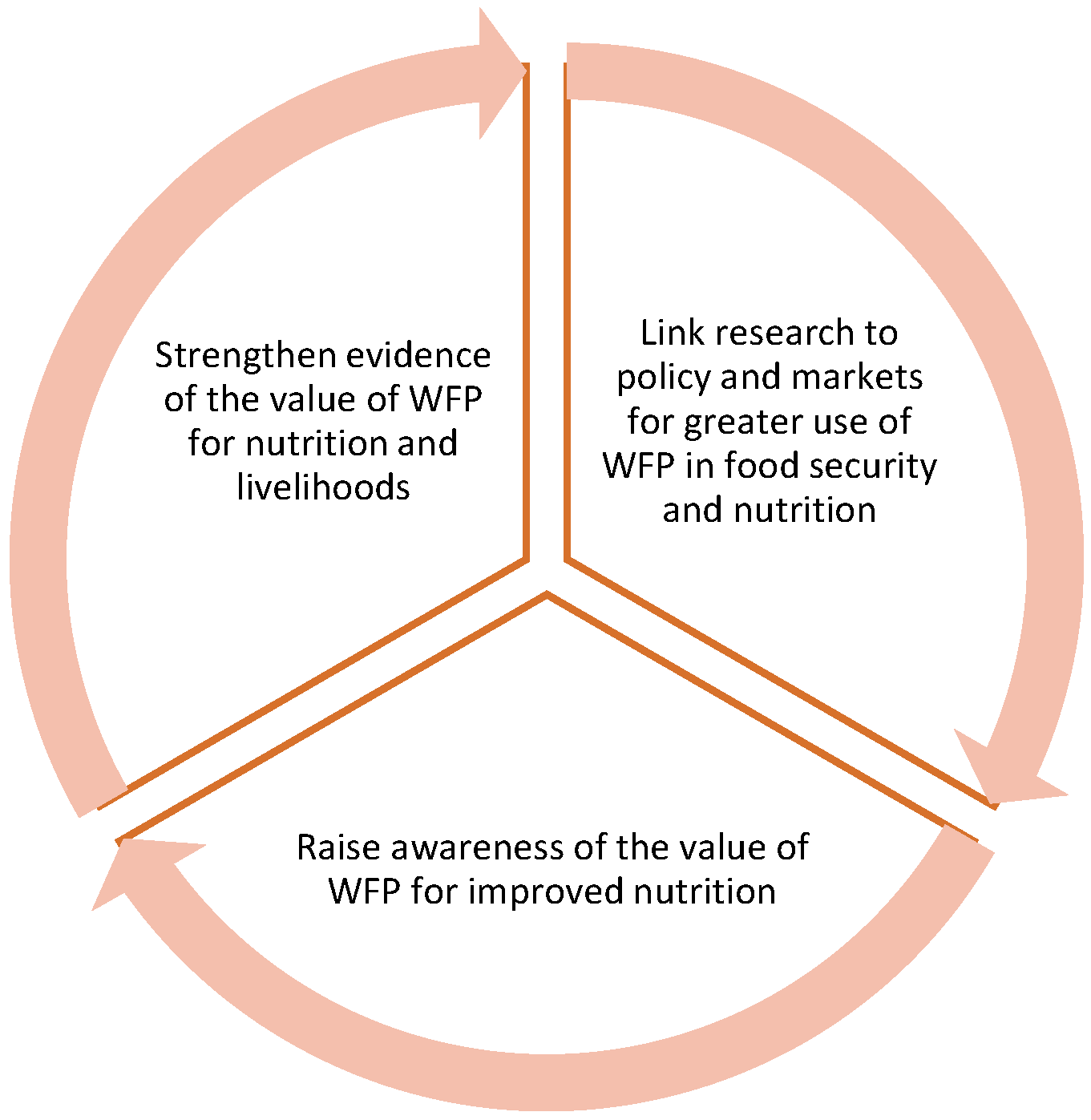
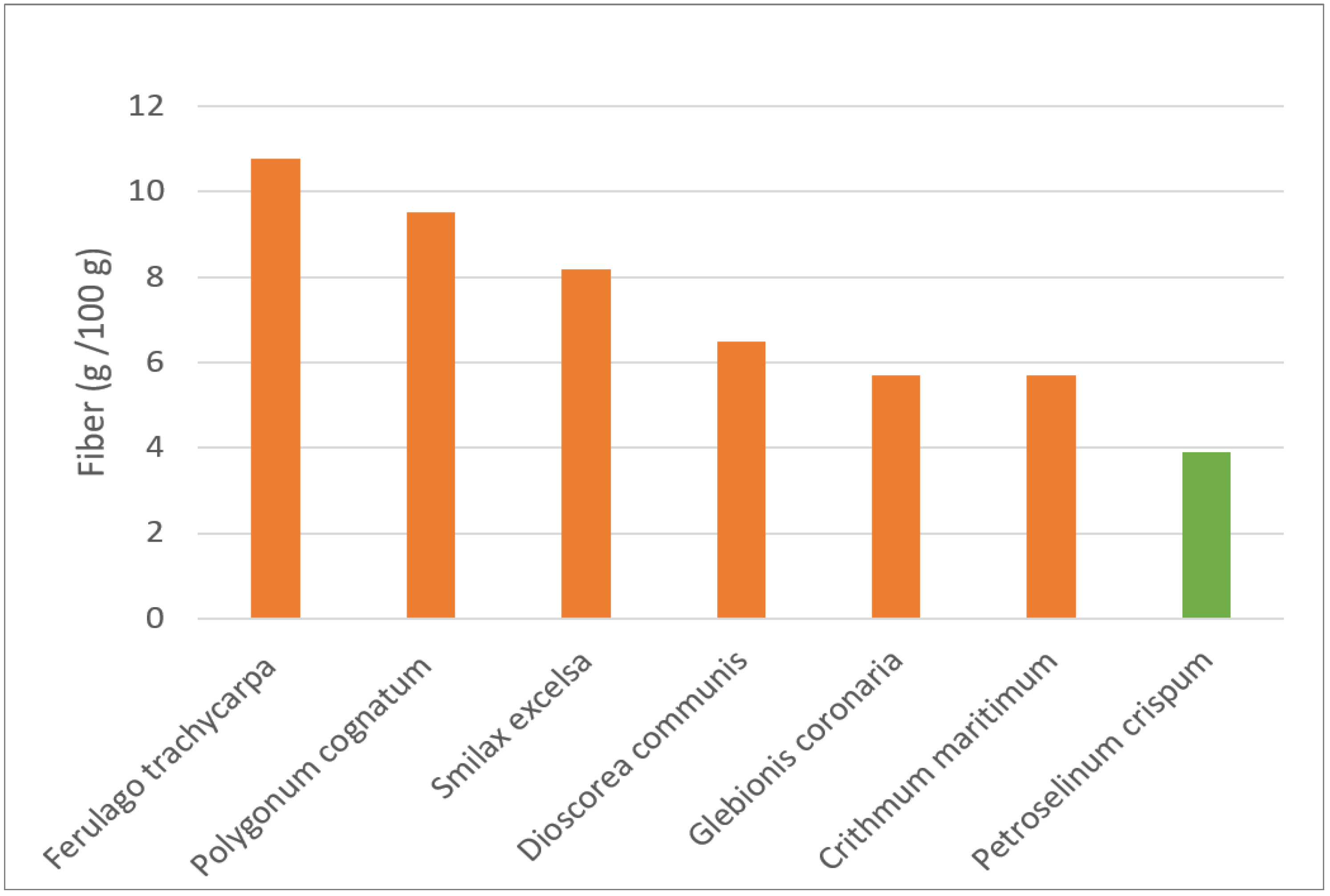
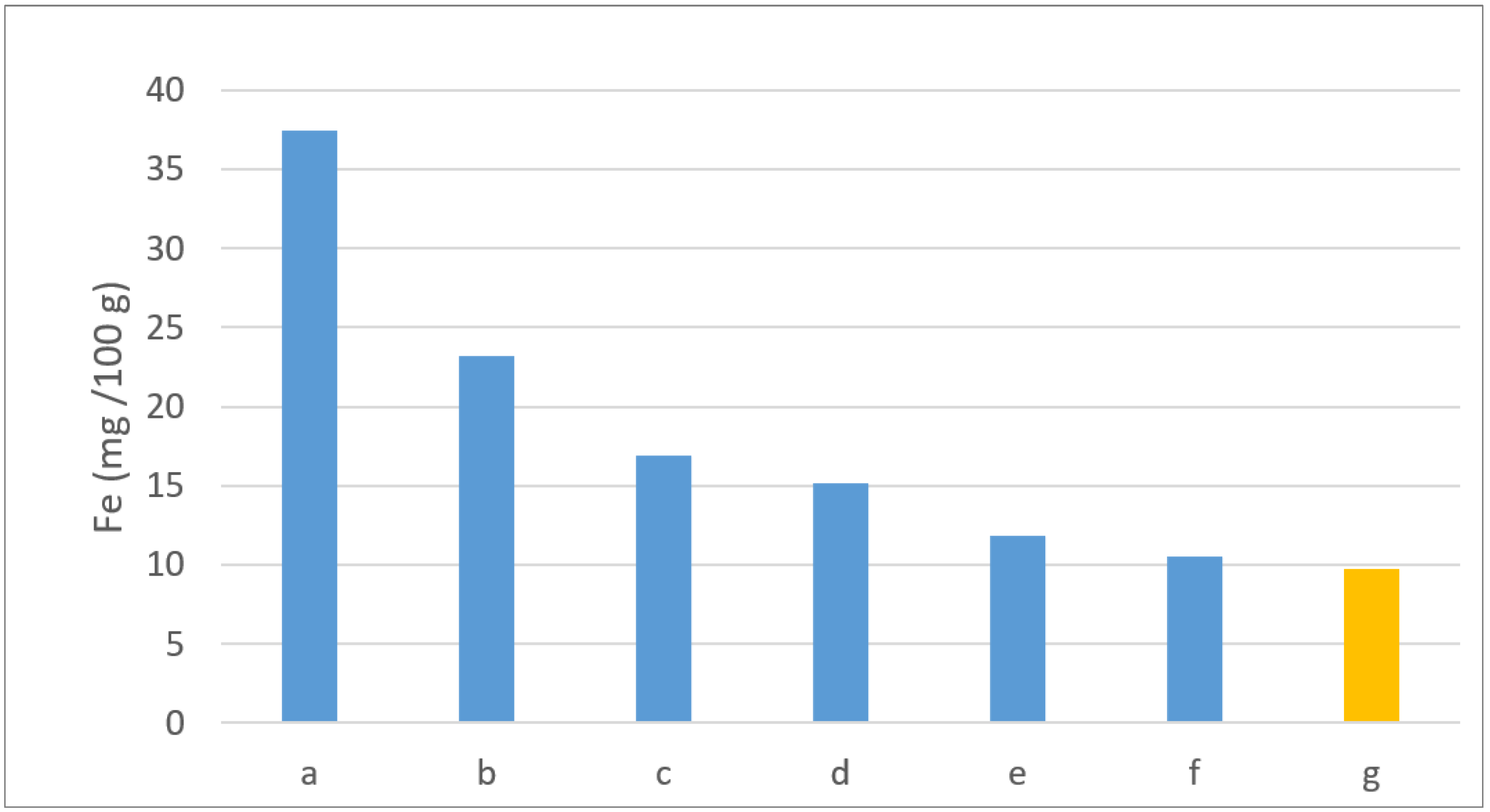


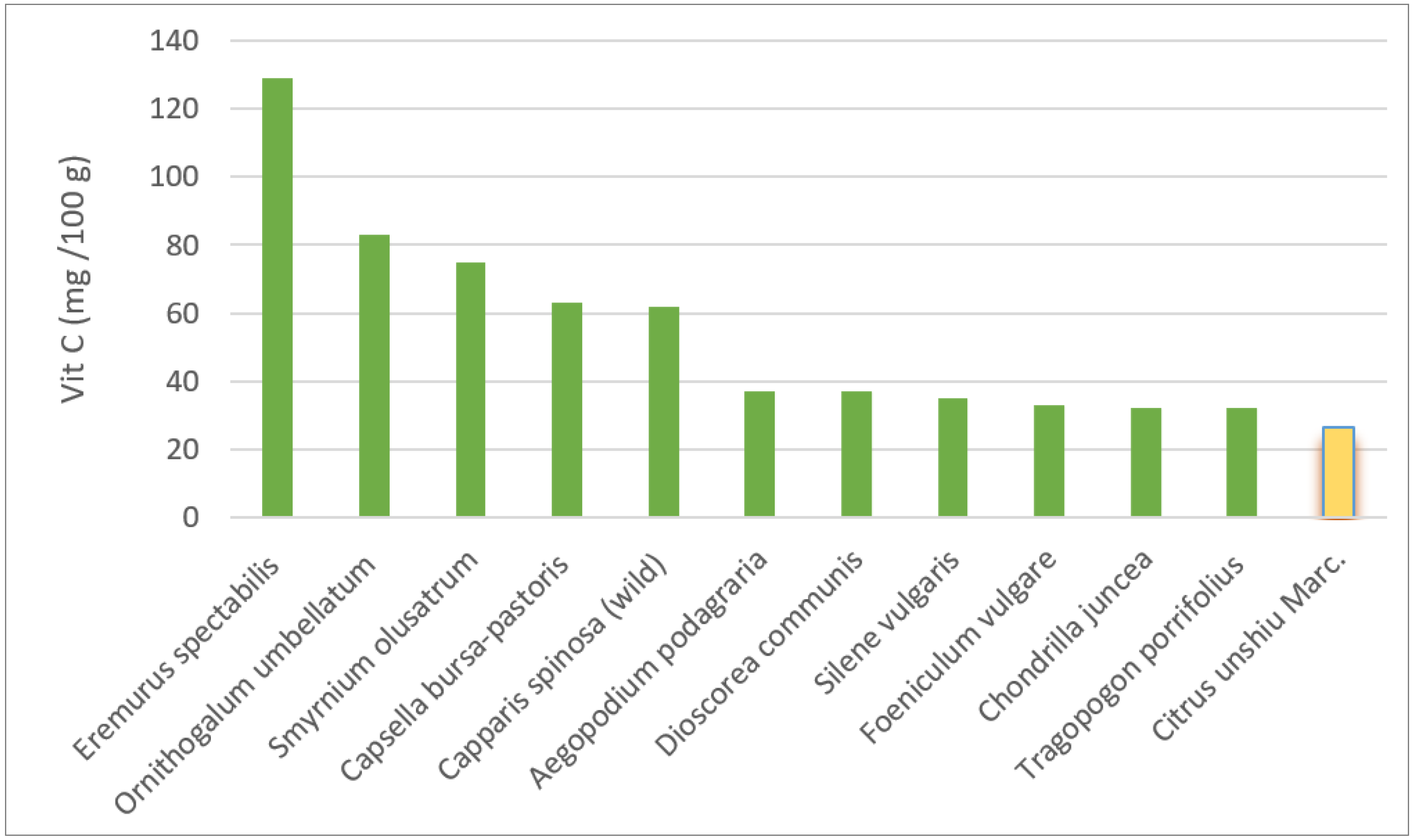
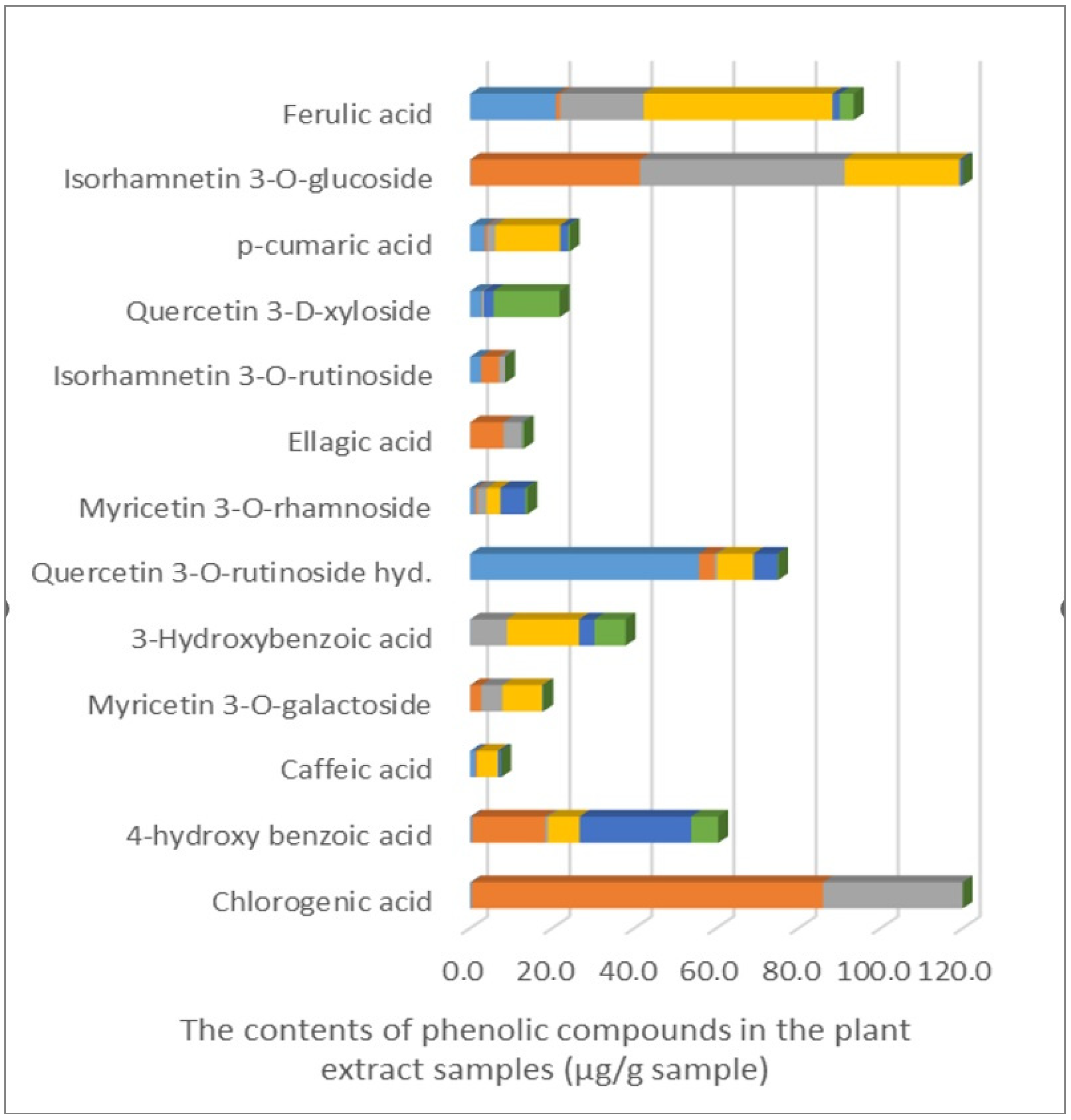
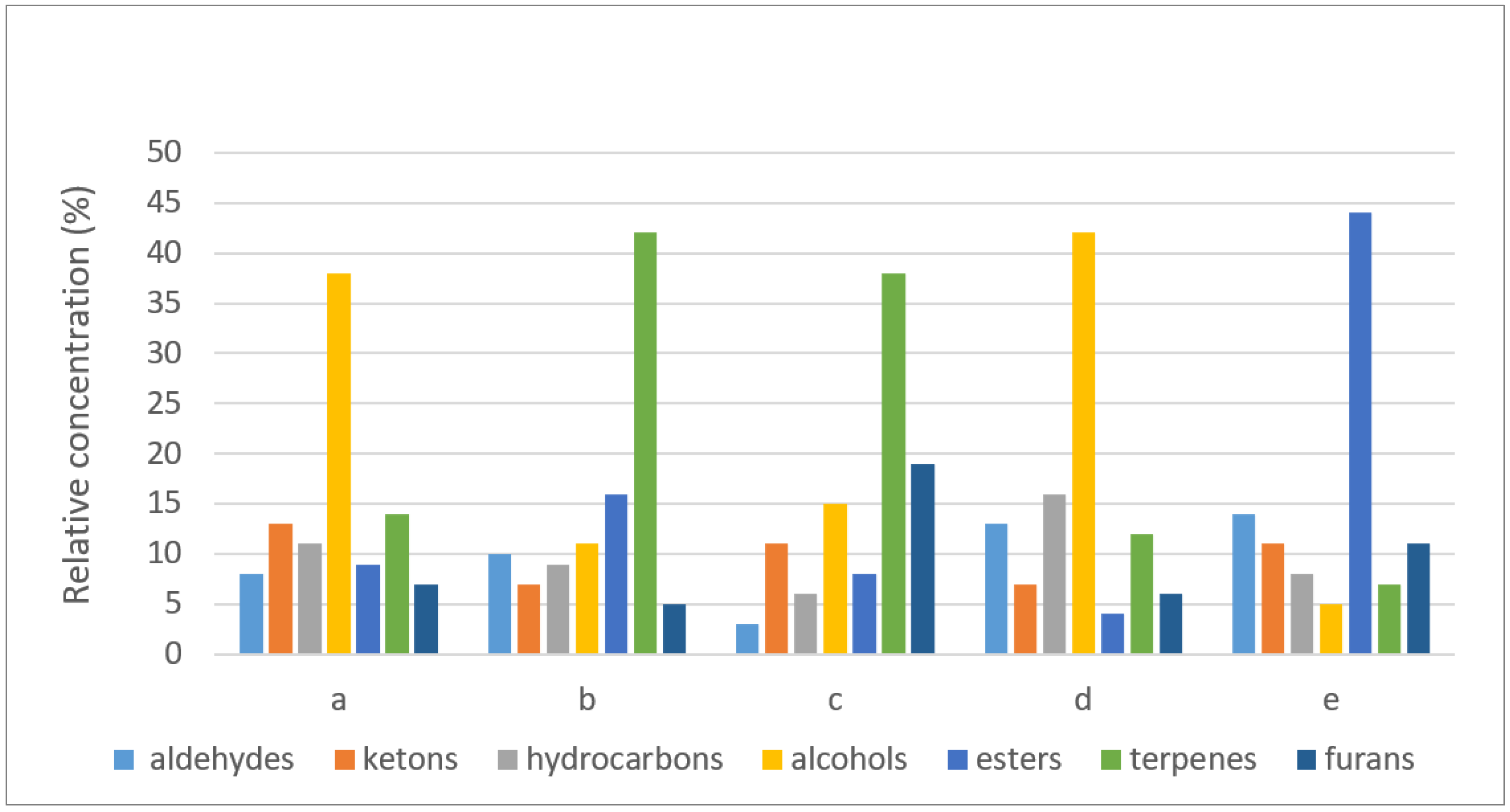

| Nutritional | Environmental | Economic |
|---|---|---|
| -Iron content -Calcium content -Fiber content -Antioxidant ratio -Beta-carotene content | Conservation status -Ex situ, in situ/on farm | Collection/Production -Constraints -Distance from collection/production sites -Collection, production stability |
| Cultivation -Ease of production -Growth rate -High adaptability -Vegetation period -Annual growth | Market characteristics -Readily identifiable -Ease of packaging -Shelf-life attributes | |
| Threats -Habitat destruction and fragmentation -Pollution -Overexploitation -Unsustainable collection practices | ||
| Distribution -Widespread | ||
| Habitat preferences |
Publisher’s Note: MDPI stays neutral with regard to jurisdictional claims in published maps and institutional affiliations. |
© 2022 by the authors. Licensee MDPI, Basel, Switzerland. This article is an open access article distributed under the terms and conditions of the Creative Commons Attribution (CC BY) license (https://creativecommons.org/licenses/by/4.0/).
Share and Cite
Borelli, T.; Güzelsoy, N.A.; Hunter, D.; Tan, A.; Karabak, S.; Uçurum, H.Ö.; Çavuş, F.; Ay, S.T.; Adanacıoğlu, N.; Özbek, K.; et al. Assessment of the Nutritional Value of Selected Wild Food Plants in Türkiye and Their Promotion for Improved Nutrition. Sustainability 2022, 14, 11015. https://doi.org/10.3390/su141711015
Borelli T, Güzelsoy NA, Hunter D, Tan A, Karabak S, Uçurum HÖ, Çavuş F, Ay ST, Adanacıoğlu N, Özbek K, et al. Assessment of the Nutritional Value of Selected Wild Food Plants in Türkiye and Their Promotion for Improved Nutrition. Sustainability. 2022; 14(17):11015. https://doi.org/10.3390/su141711015
Chicago/Turabian StyleBorelli, Teresa, Nurcan Ayşar Güzelsoy, Danny Hunter, Ayfer Tan, Sevinç Karabak, Huriye Özgül Uçurum, Filiz Çavuş, Saadet Tuğrul Ay, Neşe Adanacıoğlu, Kürşad Özbek, and et al. 2022. "Assessment of the Nutritional Value of Selected Wild Food Plants in Türkiye and Their Promotion for Improved Nutrition" Sustainability 14, no. 17: 11015. https://doi.org/10.3390/su141711015
APA StyleBorelli, T., Güzelsoy, N. A., Hunter, D., Tan, A., Karabak, S., Uçurum, H. Ö., Çavuş, F., Ay, S. T., Adanacıoğlu, N., Özbek, K., Özen, B., Tokat, E., & Taşçı, R. (2022). Assessment of the Nutritional Value of Selected Wild Food Plants in Türkiye and Their Promotion for Improved Nutrition. Sustainability, 14(17), 11015. https://doi.org/10.3390/su141711015








